
SPINEXPO Shanghai: Create and educate
The 15th edition of SPINEXPO Shanghai, held at the Pudong Expo Centre, Shanghai, China March 9th-11th, 2010, featured the Spring/Summer 2011 collections of over 142 top-level textile and fibre promoters from 16 countries. The event attracted 9,618 international attendees, (a slight increase over the previous edition). Japan visitors numbered 628 (the largest showing after China). The number of European (185) and American (98) visitors were equally stable, with fewer

30th March 2010
Knitting Industry
|
Shanghai
 The 15th edition of SPINEXPO Shanghai, held at the Pudong Expo Centre, Shanghai, China March 9th-11th, 2010, featured the Spring/Summer 2011 collections of over 142 top-level textile and fibre promoters from 16 countries.
The 15th edition of SPINEXPO Shanghai, held at the Pudong Expo Centre, Shanghai, China March 9th-11th, 2010, featured the Spring/Summer 2011 collections of over 142 top-level textile and fibre promoters from 16 countries.
The event attracted 9,618 international attendees, (a slight increase over the previous edition). Japan visitors numbered 628 (the largest showing after China). The number of European (185) and American (98) visitors were equally stable, with fewer representatives from each company, but more companies representing each continent.
The exhibition showcased an international mid-to-top of the range offering of textile fibres and yarns for flat bed, circular knits, weaving and accessories manufacturers, innovative knitting machinery technology, as well as the latest developments from the knitwear design studios.
In addition to the extensive range of yarns for hand flat knitting, a growing number of exhibitors featured an interesting collection of yarns for circular knitting (fabrics/lingerie). This inspired the SPINEXPO creative team to develop a presentation of an "Activewear/Streetwear" range, influenced by the world of sport (Yoga, Dance, Tennis, Golf, Jogging) and its reintegration into daily use, and to which the innovative fibres give a new lease of life, creating an informal, active fashion line aimed at the young and contemporary mass market. China is currently the cradle of research for most new fibres - milk protein, bamboo, soy, hemp, linen, yak, etc. This combined with its warm, humid climate and fact that the vast majority of its population is under 30 years old-make China conducive to the development of this market sector.
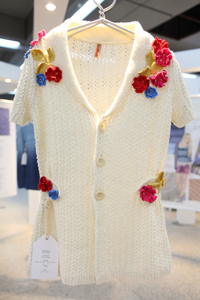 Another major avenue for the development of new products lies in the organic and recycling sector, which has been relaunched with a focus on birth and childhood and marketed under the name "Healthy Beginnings", which highlights the importance of using environmentally sustainable textiles from the very start of our children's lives.
Another major avenue for the development of new products lies in the organic and recycling sector, which has been relaunched with a focus on birth and childhood and marketed under the name "Healthy Beginnings", which highlights the importance of using environmentally sustainable textiles from the very start of our children's lives.
The Forum was conceived and coordinated by Sophie Steller, a design studio and consultancy in the United Kingdom, with the assistance of Carruthers Associates in Scotland, Giovanni Cavagna in Italy and with the cooperation of Hong Kong Polytechnic University and Nottingham Trent University.
Spring/Summer 2011 reflects the desire for a change of direction and finding a new energy to move forward. The concept of white is explored by creating a range of colours that reflect the trend of saturation and vibrancy versus washing down and whitening of colour into soft muted tones, so one trend can be translated to create very different unique effects.
Colours: A soft, muted palette of whitened neutrals and subtle tints, with a delicate touch of metallics.
Concept: Yoga and dance are an important influence, while looking at drape and volume working with function.
Fabrics: Sophisticated and delicate with fine textures and tonal plays of colour. The delicate and feminine are contrasted with abstracted, harder edged embellishments making the look modern and strong, but not too pretty. Comfort and ease balance with dressy to give a relaxed polished feel.
Yarns: Crisp, Dry, Delicate, Soft, Fluid, Extra fine, Peached and washed, Refined, Luxurious, Sheen vs. Matt, Glossy, Stretch, Subtlety textured.
Constructions: Micro textures and tucks, abstract pointelle, blown out crochet, subtle ombré stripes, drop stitches, architectural cables, folding and pleats, gathered effects, two-tone tucks, sheers and layering, crinkled looks, textures through yarn mixtures, open and gauzy.
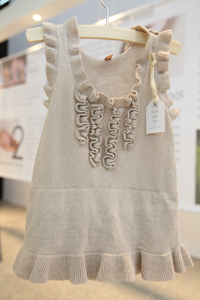 Colours: A refreshing palette of blues ranging from dark to light, accented with purple and enriched by deep red and yellow.
Colours: A refreshing palette of blues ranging from dark to light, accented with purple and enriched by deep red and yellow.
Concept: The story it tells is romantic but tough, pretty and crafted, with a slightly washed and worn feeling. The fabrics have a free open road spirit, with pretty embroideries, stripes and ginghams alongside tie-dyes, printed and denim-like finishes. A multi-layered feeling combining interesting textures, surfaces and print techniques all together in one look.
Yarns: Tie dye and space dye, Washed denim looks, Muted heather effects, Mercerized or glazed, Papery hand feels, Peached and washed handles, Crisp cottons, Open ended slubs and roving looks, Linens blended with soft yarns for a worn look, Textured, crinkly or surface interest.
Constructions: Chunky tuck ribs, tonal plaiting, double layered fabrics, finishing techniques such as printing and washing, hand crochet both fine and chunky, hand embroidery, mini checks, exposed seams, raw edges, patchwork, Aran cables, fisherman ribs.
Colours: Crisp white, navy and sharp greys combine with refreshing active brights and touches of neon that play in tonal combinations.
Concept: Activity and sport dominate this look. Stripes, colour blocking and athletic-style layering are modernized by creating ripples, waves and liquid looks. Draping and folding yarns and fabrics in new ways create origami effects. Technical functions are an important aspect to enhance expected performance. This story brings sporty looks into the mainstream for everyday wear.
Yarns: Matt and compact, Glossy and fluid, Crisp and dry, Technical properties, Stretch, Clean mercerized cottons, Fine viscose matt and shine, New technical finishes, Shimmery touches or metallic finishes, Polished and draped, Compact and super soft.
Constructions: Mini retro sport textures such as waffles, piques and thermal structures, pleats, engineered ribs, colour blocking and bold stripes, new argyles and graphic intarsia, spots and checks, ½ Milano and double knits for compact fabrics, piping and ripple stitches.
Colours: Deep saturated brights, rich and warm are grounded by honey-toned neutrals and a hint of gold.
Concept: A fusion of cultures, embracing a new sense of spirit, inspire plays on patterns and stripes, with bold graphic shapes, in both tonal and clashing colour combinations. Multi-textural surface effects and fabrics can be both relaxed and casual, through to a more glamorous touch that is achieved with yarn, shape and a shimmer of gold. A handcrafted element is essential, from embellishments to knitting techniques and yarn combinations.
Yarns: Sandy and dry, Chunky and pre-twisted, Textural, Marled and mélanged, Shine contrasts with dry matt yarns, Natural elements, Slub or subtle texture, Vegetable dyes, Eco yarns such as organic, Novelty spinning such as chainettes, tape or thick and thin.
Constructions: Reverse textures, floats and woven looks, bold intarsia, naive embroidery, multi stripes, tuck stitches, textural stripes, hand made looks, hand knit and heavy crochet, beading and embellishment, blanket looks, exposed seams and finishes, purl and simple textures, relaxed open fabrics, Dyed and washed effects.
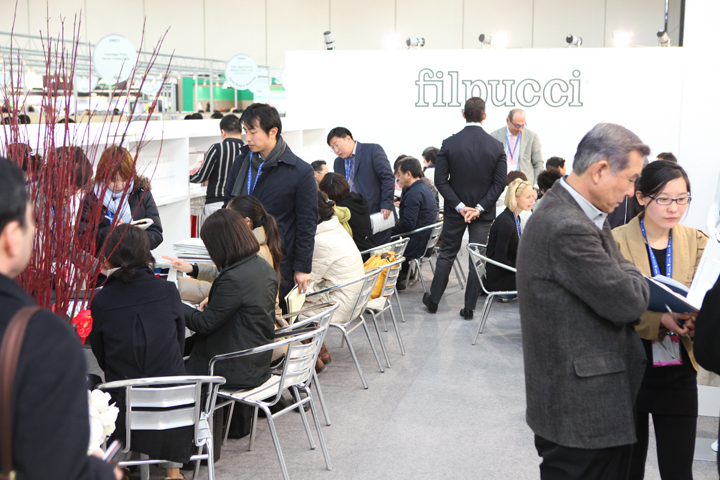 SPINEXPO recognized the growing market and importance of circular knits as an integrated part of fashion, and no longer restricted to active sports. Garments were created to allow freedom of movement, activity and comfort. Innovation in fabric composition and structure moved the idea of knits away from basics into fashionable standalone pieces.
SPINEXPO recognized the growing market and importance of circular knits as an integrated part of fashion, and no longer restricted to active sports. Garments were created to allow freedom of movement, activity and comfort. Innovation in fabric composition and structure moved the idea of knits away from basics into fashionable standalone pieces.
The designs explored 4 key directions for knits and active wear for the season:
Dance: Lightness, grace, power, discipline, study, music, rhythm, steps, energy, harmony, flight.
Yoga: Mind, body, soul, control, force, movement, balance, awareness, meditation, knowledge, silence.
Leisure: Air, freedom, running, comfort, freshness, technical, sun, breathing, fun, nature, quality.
Sport: Activity, fit, colours, game, practice, line, score, club, health, British.
LOOKING TO THE FUTURE, an area dedicated to student development and creativity and collaborated with Nottingham Trent University (United Kingdom) and Hong Kong Poly-U (Hong Kong), blended new technology, creative thinking and youthful global perspectives. The designs have been worked in a palette of whites, making the focus on yarn, fabric and detail innovations clearer with a focus on the creativity involved in developing new stitches, trims and surface interest.
This forum focused on environmentally conscious textiles and designs for childrenswear. Natural fibres are preferable as they have sustainable benefits, are regenerative without the need of chemicals and once consumed will naturally biodegrade over time:
Cotton: soft, durable, cool to the touch and absorbs moisture, and when farmed organically is completely natural and pure.
Linen: The fibre flax plant grows more quickly than cotton and needs less chemical weed controls. It produces a strong, dirt resistant fabric that is exceptionally cool in summer.
Hemp: 100% natural with a dry handle, subtle sheen and natural drape. Cool in summer and repels 90% of UVA rays, yet warm in winter. Hemp is the most renewable fibre; it grows in any soil and climate and is repellent to insects, requiring few chemicals to grow.
Bamboo: the softest fabric imaginable, is highly breathable, keeps you cool in summer and warm in winter due to its unique structure. Bamboo grows fast, has a massive yield and doesn't require any pesticides or fertilizers.
Soya and Milk Protein: a fibre that has a soft handle and lustre similar to that of silk. A particularly good fibre for blending with other natural fibres giving them added natural lustre and drape and softness.
Wool, Cashmere and fine animal fibres are naturally breathable and absorb water away from the body. When using fine microns they form the basis of the softest and most luxurious fibres. Their production uses fewer chemicals than other fibres, reducing water pollution throughout the product supply chain. Organic farming and production has more impact on children than any other consumer group. Organic yarns create a healthier consumer product. Since skin can "breathe" and absorb what is placed on it into the body, the natural purity of organic wool and cotton greatly reduces the impact of harmful chemicals exposed to the skin’s surface.
Organic sheep are managed without being fed modified feeds or dipped in harmful chemicals, which eliminates the risk of environmental contamination. Organic cotton farming eliminates the impact of chemical pesticides and fertilizers and therefore soil fertility and biodiversity is increased and water supplies remain clean and uncontaminated. A commercial alternative to dyeing is available with organic certification. Synthetic dyes that are not harmful to the skin are metal-free, low impact dyes that bond directly to the fibre, producing very little wastage and run off and make it possible to have a choice of vibrant colour. Three main certifications to look out for to help you know products are less harmful to the environment.
OE standard (Organic Exchange): certifies that the organic cotton produced meets with their standards
GOTS (Global Organic Textile Standard): awarded by Control Union who are the certification body to help govern the sourcing and processing of fibres from organic agriculture and the production of sustainable textile products.
Oeko-tex Standard 100: assures the yarns are free of concentrations of harmful substances that are detrimental to health and the environment.
Highlights from the exhibitors:
Mohair, a rare and precious protein fibre, is experiencing a comeback, which was apparent in many of the collections shown at SPINEXPO.
Mohair South Africa LTD. is an organization that provides educational research for producers and farmers, improves the quality of mohair and its global marketing. Today, South Africa is the largest mohair producer in the world.
The soft luxurious hand, the rich lustre and shine of mohair combine with great durability. With a high affinity for dyes mohair absorbs colours into its core for rich and vibrant hues. Mohair is a year-round fibre, with warm knits and wovens for the cold winter, and airy, lightweight structures and clean suiting fabrics that breathe during the summer. Pure or blended, mohair produces rich tweeds, lofty fleeces and knits. Naturally soft mohair offers an environmentally friendly alternative to real fur. Mohair fabrics are characterized by insulation properties, extremely flame retardant, and offer high sound absorbency, making it ideal for public spaces and home furnishings.
The core business for Top Line (Ningbo) Textile Co./Gruppo Lineapiu (China) is in fancy yarns, based on alpaca, wool and cashmere. Their key introduction at SPINEXPO Shanghai was mohair from South Africa, very soft and fur-like, with the added advantage of not shedding. Fine and light qualities of the ‘new mohair’ offer very clean looks.
More summery looks were developed using the finest linen from France and Belgium. Linen blends with rayon and viscose for very sheer aspects. Viscose gives shine and fluidity to blends of linen and nylon. The strength of linen is balanced in blends by the soft, delicate characteristics of silk. A denim jeans quality in 100% cotton was also new for the season.
Lana Stop (Spain) featured spaced dyed and degrade effects, merino extra fine, and superwash wool extra fine yarns from Australia for hand knitting. New qualities included blends of merino wool/silk; 100% baby alpaca, wool/cashmere, and mohair/polyamide, wool alpaca, mohair embellished with paiettes and ‘Trebol’, a chunky 100% merino that looks like felt.
Honor Textile Co. (China) showcased their smooth linen series, characterized by reduced pilling, cool and dry aspects, and increased evenness of the threads. The silk series emphasizes the ability of this fibre to retract to its previous form after stretching, producing a yarn that is light and even, soft and colourful, and has excellent properties for absorbing perspiration. Silk combines with linen, viscose or bamboo-which enhance the look and while maintaining a competitive market price.
Space-dyed effects are achieved with silk noil blended with viscose, nylon, rayon, cotton or modal. Summer wool qualities keep you cool in summer; cool acrylic-has the same handle as summer wool-soft, stretches and absorbs colour like wool, but is less expensive. It is also lightweight and pest resistant, and can be spun with natural fires to increase breathability.
Basolan Merino qualities are like mercerized wool, but softer, and were available in 100%, blends with cotton, acrylic, or viscose for a very dry hand feel. Fancy boucles with natural aspects are fine and light. Tape yarns are smooth and strong with stretch and can be knitted on 12 gauge machines. Texture is key, and is achieved with long slubs in cotton/viscose.
Long fibre cotton yarns have a cashmere feel, are soft and light, have good affinity for colour and great breathability. The Green Series emphasizes recycled cotton. Bamboo/charcoal, sometimes blended with rayon, is strong, offers warmth, deodorizes, absorbs and evaporates moisture quickly, and breaks down the chemicals in the environment-making it suitable for socks, legging and underwear. Colours are soft and natural.
UPW (Hong Kong) is known for woollen spinning, semi-worsted and fancy twisting, including 100% cashmere and blends with angora and cotton, in gauges ranging from 1 1/2 to 18. The spring/summer 2011 collection is based on very fine counts. The palette includes rich rosy colours, ranging from coral to claret, lime green and French navy.
Cotton/silk, organic cotton/Modal and lightweight organic recycled wool are key. Milk protein/soybean, linen/viscose/Tencel, bamboo/cotton, linen/cotton/bamboo, linen/cotton and linen/viscose in heavy gauges for casual looks are also important.
Lots of texture is key. There was a good reaction to glitter, and Pima cotton is big this season, especially in blends with cashmere and/or silk. New and fresh for the spring was a cashmere available in a very fine gauge.
Developments from Kyototex Shanghai (Japan) included fine yarns with metallic and Lurex effects and 100% nylon space dyed metallic yarns. A mini-collection focused on metallic dyed yarns that are Oeko-Tex certified.
Novatex (Hong Kong), a major woollen spinner, focuses on all natural fibres -lambswool, cashmere and angora with a special organic and recycled product program. Special emphasis is put on non-mulesed wool. Cottons offer a soft handle; marls and tweeds are available in chunky versions, and there is an importance on mélange colour.
In response to the request for natural fibres, the spring/summer 2011 collection from Yarns & Colors (China) included linen blends with cotton, silk or nylon with a focus on fancy yarns and chemical treatments. New developments include 100% linen or cotton in fine count or heavier yarns with a stonewashed look in denim and chambray colours achieved with dyeing techniques. The company has received the certified Oeko Tex Standard on dyeing.
Consinee, the largest exporter for cashmere yarn in China, developed yarns based on interesting raw materials. Trendy new introductions with a warm touch included dehaired yak from Tibet, combined with wool and/or cashmere for softness. 100% raccoon, a longer hair fibre than yak, also dehaired, offers a more hairy or furry aspect.
Cashmere is blended with water-soluble PVA before spinning. The PVA dissolves during the washing process, leaving a 100% cashmere quality that is light and bulky and suitable for low gauges. Blends of cashmere with Lurex offer a desirable touch of shine.
Linificio & Canapificio Nazionale (Italy) is the largest European spinner of long line flax yarns for weaving and knitwear. Their offering includes a complete line of dyed fancy yarns. The company is also a supplier of raw and bleached, linen and hemp tops, used in the production of yarns. Linificio yarns are Masters of Linen, OEKO-TEX and EKO Sustainable Textile certified. The fashion collection of yarns includes knitting yarns, hand spun yarns, slubby yarns, slivers and top dyed mélange yarns. New qualities for Spring/Summer 2011 include linen/cashmere; linen/silk-in a very fine count; linen/nylon and 100% hemp.
Raw materials are sourced from Belgium, France and Russia, resulting in a long fibre linen quality that is very fine and doesn’t break. Linificio emphasizes organic linen (Bioflax), which comes from a plant never treated with chemicals.
Carriagi (Italy), specialists in fine fibres, combined their artisan skills with technology for a collection of ultra-light worsted and carded yarns. Cashmere/wool, extra fine merino wool/silk and cashmere/silk yarns made using a special twist have a crisp finish and are perfect for year-round use.
Antibacterial 2 / 80 count 100% Merino Wool Extrafine Superior yarn has been treated with nano-particles of silver, known to the Ancient Egyptians for its purifying properties and after used as a bactéricide. Pukaki Waterproof, a 2 / 48 count - 100% New Zealand Merino Wool, is a mercerized oil and water-repellent yarn treated with Teflon ® fabric protector, resulting in a stain proof and waterproof yarn that does not alter the original characteristics and breathability of the yarn.
Cariaggi continues its research into natural colour applications. Guado (woad – an ancient dye plant typical of the Montefeltro area), has been applied to Antelope, a worsted 100% Merino Wool Extrafine Superior yarn producing five mélanges inspired by shades of blue denim. Cashmere /silk Jaipur Indigo continues the blue theme in eight different shades.
Huafu Top Dyed Mélange Yarn Co. (China) introduced their new colours, ranging from raspberry and apricot, to colors of the sea like navy blue-on their collection of yarns for circular knitting, flat bed knitting and wovens in top-dyed mélange. The palette is natural, springtime fresh and harmonious for fabrics that are beautiful and offer clean aspects.
Jiangsu Lugang Science & Technology Co. (China) featured a mélange in viscose/dehaired angora, new spaced dyed effects in Tencel/poly/wool and colour change effects in 100% acrylic. Viscose blends with milk fibres, bamboo/viscose, lyocell/pearl fibre/cotton/viscose and silk/lyocell/bamboo charcoal fibre/ viscose yarns were available from the Xinao Group (China).
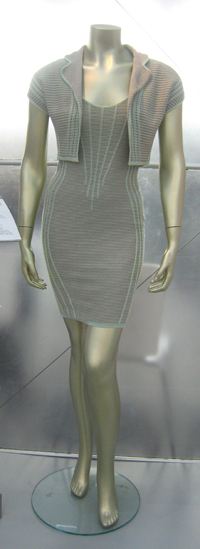 Scotcloth (UK) demonstrated their tool for textile designers based on the ScotWeave computer aided design and management system. The program can be used to view a comprehensive library of textile images and allows the operator to engineer existing images to their own requirements by altering weave or other constructions, dimension and colour on screen and then download their unique design in print form, or send the image, together with technical manufacturing details, including Pantone® colour references, to anywhere they choose. The library includes a design archive with over 70,000 images for clothing and furnishing fabrics and a wide range of fabric constructions.
Scotcloth (UK) demonstrated their tool for textile designers based on the ScotWeave computer aided design and management system. The program can be used to view a comprehensive library of textile images and allows the operator to engineer existing images to their own requirements by altering weave or other constructions, dimension and colour on screen and then download their unique design in print form, or send the image, together with technical manufacturing details, including Pantone® colour references, to anywhere they choose. The library includes a design archive with over 70,000 images for clothing and furnishing fabrics and a wide range of fabric constructions.
The Stoll Fashion and Technology Center (Germany) launched two special presentations themed in ‘Jacquard Knitting and special edition Pattern Library related to Jacquards’ and ‘China Trend Collection-Knitting Techniques and Design features in combination’. Stoll also presented their new China Trend Fashion Collection for Spring/Summer 2011.
Santoni (Italy), the worldwide leader of seamless machinery, presented their new and never before exhibited complete rib border seamless knitwear, and seamless warp garments made with the first specially designed Compact Seamless Warp machine. On view was a complete collection of seamless knitwear made with a circular knitting machine in association with the designer G. Cavagna.
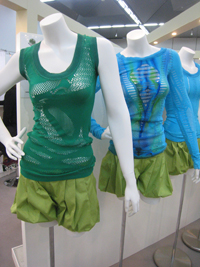 Knit structures of various kinds, including eyelet fabrics and sober mini-jackets were featured, made on the new Rib 6 and TR machines, which reach up to 20 gauge, and can be produced in very high quantities and require very little post-knitting labour.
Knit structures of various kinds, including eyelet fabrics and sober mini-jackets were featured, made on the new Rib 6 and TR machines, which reach up to 20 gauge, and can be produced in very high quantities and require very little post-knitting labour.
Kamful – Hong Kong is one of the largest factories in the world producing knitted and woven garments hand-painted with designs developed exclusively by the company's team of artists and graphic artists. Patents protect many of its processing techniques.
Upcoming editions:
SPINEXPO New York, 2nd edition
July 19-21st, 2010
The Metropolitan Pavilion/Altman Building-125/135 West 18th St. NYC
Autumn/Winter 2011-12 collections
SPINEXPO Shanghai, 16th edition
September 7-9th, 2010
Shanghai Pudong Expo, Shanghai, China
Autumn/Winter 2011-12 collections

Business intelligence for the fibre, textiles and apparel industries: technologies, innovations, markets, investments, trade policy, sourcing, strategy...
Find out more